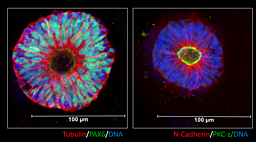Single Rosette Brain Organoids
TECHNOLOGY NUMBER: 2020-255

OVERVIEW
Uniform brain organoids from human-derived induced pluripotent stem cells- Rosette models having consistent morphology with single, centrally located lumen
- A three-dimensional culture tool for predictive toxicology and drug discovery
BACKGROUND
The first four weeks of human fetal development include the formation of a neural tube that subsequently develops into the brain and spinal cord. During embryogenesis, clusters of cells in what are known as 'neural rosettes' form in radial arrangements of columnar cells along the length of the neural tube. Rosettes express proteins that influence neighboring cells to differentiate into neurons, oligodendrocytes, and astrocytes. Neural networks derived from stem cells, however, produce multiple organizing centers resulting in non-reproducible, disorganized neural circuits. Identifying technical means to address this problem would aid researchers in developing scalable and reproducible neural networks with applications in drug development and precision medicine. While the development of cultured neural networks from stem cells is a promising method for scientists to develop and test neural drugs in vitro, the ability to develop standardized research systems remains a challenge. As such, a need exists for new methods to reproducibly create these models.
INNOVATION
Researchers at the University of Michigan have created a technology which provides a technique to reproducibly produce human brain organoids from pluripotent stem cells. The invention involves treating stem cells with small molecules to give rise to developmentally timed neural networks. The scientists developed a technique that produces human, self-organizing single-rosette brain organoids (SOSRS) that generate excitatory cortical-like neurons. The SOSRS have a consistent diameter and can be grown relatively quickly, producing neurons from multiple cortical layers. This culture system enables researchers to study development of neural structures as well as the effects of drugs on the neurons. The model can also be modified to develop inhibitory neurons which have been shown to be present in diseases such as autism and schizophrenia. As such, this invention shows a potential method for evaluating novel therapeutic agents for a variety of common and debilitating diseases.